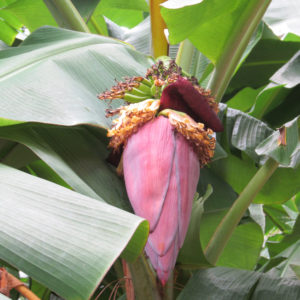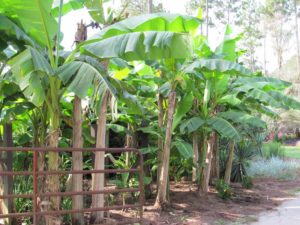 If you lust for warm sunny beaches and tropical jungles then growing bananas trees in your garden is a sure way to transport yourself to the tropics without an expensive plane ticket. Fruiting your own bananas gives you a rare treat that few gardeners can enjoy.
If you lust for warm sunny beaches and tropical jungles then growing bananas trees in your garden is a sure way to transport yourself to the tropics without an expensive plane ticket. Fruiting your own bananas gives you a rare treat that few gardeners can enjoy.
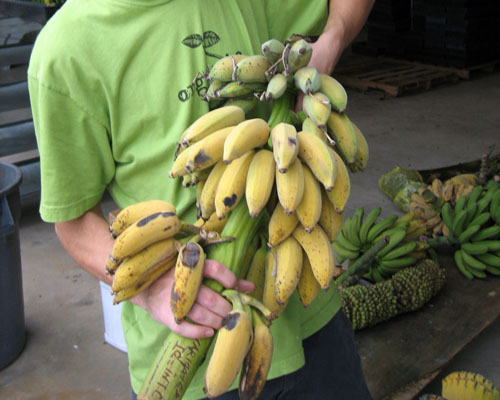 In the landscape, the broad, flat leaves of the banana really stand out.  They thrive in low wet spots or on the edges of ponds.  When thinking about what varieties to plant where remember the different mature heights of the various varieties. Often mixing tall growers like STEVE’S THREE STORY (25 Foot Tall Grower) with shorter growers like APPLE (12-15 Foot Tall Grower) can create a lovely tiered planting. For more color in the landscape try mixing some of the more outrageous ornamental red foliage varieties like ROJO (8-10Foot Tall Grower) and ABYSSINIAN (18-20 Foot Tall Grower) It’s ok the mix in ornamental bananas with your fruiting varieties, it won’t affect their ability to fruit.
In the landscape, the broad, flat leaves of the banana really stand out.  They thrive in low wet spots or on the edges of ponds.  When thinking about what varieties to plant where remember the different mature heights of the various varieties. Often mixing tall growers like STEVE’S THREE STORY (25 Foot Tall Grower) with shorter growers like APPLE (12-15 Foot Tall Grower) can create a lovely tiered planting. For more color in the landscape try mixing some of the more outrageous ornamental red foliage varieties like ROJO (8-10Foot Tall Grower) and ABYSSINIAN (18-20 Foot Tall Grower) It’s ok the mix in ornamental bananas with your fruiting varieties, it won’t affect their ability to fruit.
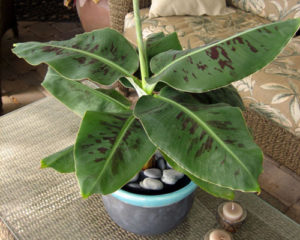 Bananas have a very shallow root system and fruiting dwarf varieties like TRULY TINY (2-3 Foot Tall Grower) and DWARF RED (5-7 Foot Tall Growers) are well suited for containers. Put them in large planters around the pool or out on the patio for a spot of tropical WOW! Add ginger lilies and sago palms for a jungle of your own.
Bananas have a very shallow root system and fruiting dwarf varieties like TRULY TINY (2-3 Foot Tall Grower) and DWARF RED (5-7 Foot Tall Growers) are well suited for containers. Put them in large planters around the pool or out on the patio for a spot of tropical WOW! Add ginger lilies and sago palms for a jungle of your own.
FRUITING BANANAS
Growing bananas in the tropical climates of zones 10 through 11 are a breeze. They often fruit the second year after planting and continue to produce yearly with good fertilizer and water. Bananas will grow and fruit in the colder regions of the lower south (Zones 8b and 9). It takes two things to be successful: (1) a variety that will fruit in short growing cycle (most take 2 years) Â and (2) planting, feeding, and maintaining the clumps. Short cycle bananas varieties fruit after they have produced about 40-42 leaves. If you live in Zone 8b through 9a and cold weather arrives before your plant’s flower, they will often re-sprout in the spring and produce fruit the second year. People in colder regions can dig the bulbs up and store in a basement to replant the following spring.
SHORT CYCLE BANANAS
Some of the easiest short cycle banana varieties to fruit are as follows:
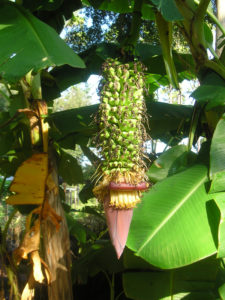 DWARF ORINOCO Dwarf Orinoco is a stout wind resistant variety with a good degree of cold tolerance. We find this one easy to fruit in short season areas. Large, thick banana with an orange-fleshed. Cook as a plantain or eat fresh off the tree.  The trees are short growers 8 to 10 ft. Zones 8-11.
DWARF ORINOCO Dwarf Orinoco is a stout wind resistant variety with a good degree of cold tolerance. We find this one easy to fruit in short season areas. Large, thick banana with an orange-fleshed. Cook as a plantain or eat fresh off the tree.  The trees are short growers 8 to 10 ft. Zones 8-11.
ICE CREAMÂ Everything is white about Ice Cream banana. The plant is covered with a silvery-white powder and when the fruit is ripe, the snow-white flesh is honey sweet and it tastes like vanilla ice-cream. Honest! Trees grow 12-14 foot tall. Zones 8-11.
RAJI PURI If you only want one variety of banana, get Raji Puri. It is the strongest grower, and easiest to fruit. This native of India rarely exceeds 8 feet in height. The tough trunks are cold, wind and disease resistant. The ‘bunch’ of bananas is large up to 30 to 40 pounds, and each fruit in the ‘hand’ is 5-6 inches. Raji Puri flavor is excellent. Its dwarf size makes it an excellent container plant for colder climates. Zones 8-11.
THOUSAND FINGERÂ Thousand Finger bananas only produce female flowers, so in long season climates will continue to set fruit throughout the season. The clumps of banana can often be 5 to 6 foot long with literally a thousand fingers of banana. The fruit are bit size, sweet and crunchy. Does well in areas with short summers. Trees will grow up to 10 to 12 foot tall. Zones 8-11.
PLANTING AND CARE:
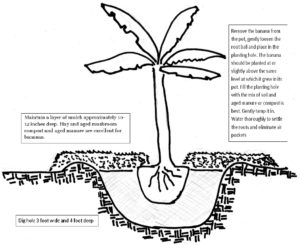 The first step is planting them in the right spot. Look to plant your trees in a place sheltered from cold north winds– the longer the growing season, the more tree ripened fruit you will have.They will grow more vigorously and produce more fruit in full sun. If you are blessed with a wet area or soil high in clay, there is little preparation besides digging a hole and planting. Sandy soils require digging a large hole and adding manure or compost, the more the merry, there is no such thing as over doing it when growing bananas. Next, plenty of water. We strongly recommend an irrigation system set up on a timer, regular watering ensures the fastest growth. Apply a balanced fertilizer like you would use in your vegetable garden the first year. You’re just building a strong
The first step is planting them in the right spot. Look to plant your trees in a place sheltered from cold north winds– the longer the growing season, the more tree ripened fruit you will have.They will grow more vigorously and produce more fruit in full sun. If you are blessed with a wet area or soil high in clay, there is little preparation besides digging a hole and planting. Sandy soils require digging a large hole and adding manure or compost, the more the merry, there is no such thing as over doing it when growing bananas. Next, plenty of water. We strongly recommend an irrigation system set up on a timer, regular watering ensures the fastest growth. Apply a balanced fertilizer like you would use in your vegetable garden the first year. You’re just building a strong 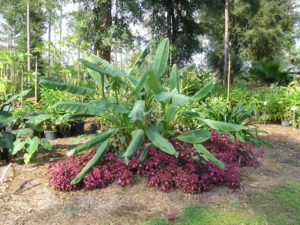 plant the first year, so apply one cup of good garden fertilizer monthly during the warm growing season. Beginning the second year the bananas you’ll be fertilizing for fruit. Use a fertilizer high in nitrogen and potassium. Organic gardens can make their own fertilizer by mixing 1 part cottonseed with 3 parts wood ash or Sulfate of Potash 0-0-22. Apply 4-5 cups monthly during the warm growing season.
plant the first year, so apply one cup of good garden fertilizer monthly during the warm growing season. Beginning the second year the bananas you’ll be fertilizing for fruit. Use a fertilizer high in nitrogen and potassium. Organic gardens can make their own fertilizer by mixing 1 part cottonseed with 3 parts wood ash or Sulfate of Potash 0-0-22. Apply 4-5 cups monthly during the warm growing season.
LIMIT YOUR TRUNKS
For best fruiting, it is important to limit the number of trunks in each plant. The life cycle of a banana trunk is to grow, fruit and die, so new trunks are needed to continue the life of the plant. The best system is 3 trunks staggered in age from fruiting size to newly emerging trunks. The right way to achieve this is to pick a new trunk every 3 or 4 months during the active growing season. Monthly cutting off of undesirable trunks will ensure the plant’s energy is concentrated into the three chosen trunks. These undesirable trunks can be chopped up and returned as mulch to the plant.
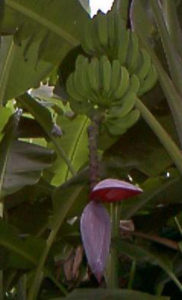 Another important factor to ripening early fruit is to remove the flower bud after you see no more fruit forming. These flowers that form late in the season are males and will not turn into fruit.
Another important factor to ripening early fruit is to remove the flower bud after you see no more fruit forming. These flowers that form late in the season are males and will not turn into fruit.
MULCHING
Bananas love moist soils, rich in organic material.  One of the key points to growing healthy, happy bananas is to maintain a layer of mulch approximately 10-12 inches deep in a 5-6 foot area around the banana clumps. Use whatever you have, leaves, hay, lawn clippings. If you compost, build your bin next to the banana patch, the runoff from the aging compost will benefit and fertilize the bananas.
FROST PROTECTION
TROPICAL ZONESÂ 9-10Â Folks living in the tropical areas of the country may not receive any freeze damage on their plants. On an occasional cold winter, they may have just the tops and tips damaged. On those years it will necessary to remove the dead leaves and tips of the trunks to help new growth emerge in the spring. On dead tips start at the top of the plant and cut a few inches off, looking for the green live center.
FOR ZONE 8A – 8BÂ Bananas are quite winter-hardy in these zones but are often killed to the ground. If you want fruit on your banana trees they must be protected from winter cold. We suggest that the plants be surrounded by a wire cage and mulched heavily with leaves. The cage should be topped with tar paper or plastic to keep the trunk dry in the winter. Remove the cage and mulch in the spring after it warms.
FOR ZONE 7A AND COLDER In theses area winter often kills the trees, but you can still grow banana with some success. In the fall choose the strongest trunks and cut off to 6 to 8 foot. Dig up the trunks and store for the winter in a basement or garage that stays above freezing.
HARVEST
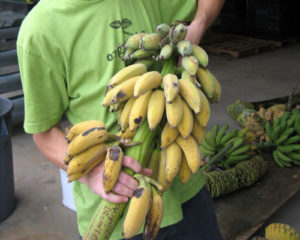 Bananas are ready to harvest when the skin turns a golden yellow. Often in colder regions, the summers are so short you can only get a few of the fruit to ripen before cold weather sets in. If this is the case do not think you have lost production. Before the first frost cut your stalk of bananas off and hang it in a warm dark place, any bananas that are 3/4 grown will continue to fill out and ripen off the plant.
Bananas are ready to harvest when the skin turns a golden yellow. Often in colder regions, the summers are so short you can only get a few of the fruit to ripen before cold weather sets in. If this is the case do not think you have lost production. Before the first frost cut your stalk of bananas off and hang it in a warm dark place, any bananas that are 3/4 grown will continue to fill out and ripen off the plant.
 In the tropics, nothing is wasted on a banana plant. You can harvest young tender banana leaves throughout summer. They are an excellent vessel for steaming rice and meat. The flower bud that has finished forming female flowers is also harvested and eaten as a savory vegetable.
In the tropics, nothing is wasted on a banana plant. You can harvest young tender banana leaves throughout summer. They are an excellent vessel for steaming rice and meat. The flower bud that has finished forming female flowers is also harvested and eaten as a savory vegetable.
